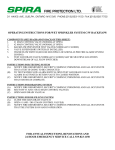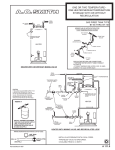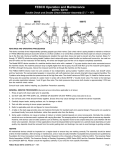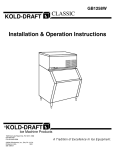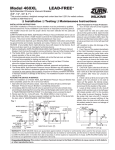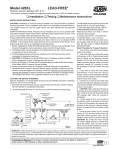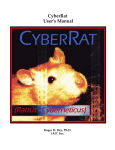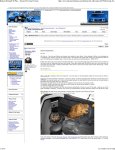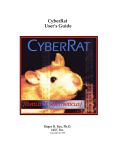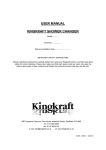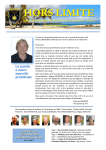Download Installation Manual
Transcript
Reduced Pressure Principle Backflow Preventers Model RPZE - Sizes 3/4" thru 2" Model RPZE II - Sizes 1/2" - 3/4" & 1-1/2" Installation, Testing & Maintenance Manual Basic Installation Instructions CAUTION: Installation of Backflow Preventers must be performed by qualified, licensed personnel. Faulty installation could result in an improperly functioning device. NOTE: CHECK WITH GOVERNING AUTHORITIES FOR LOCAL INSTALLATION REQUIREMENTS. The installer should be sure the proper device has been selected for the particular installation. FLOMATIC Models RPZ/RPZ II Reduced Pressure Principle Backflow Preventers are for use on potable water lines where a health hazard could exist if a backflow or backsiphonage situation were to occur. Proper performance is dependent upon following these installation nstructions and prevailing governmental and industry standards and codes. Failure to do so, according to FLOMATIC'S Limited Warranty "releases FLOMATIC of any liability that it might otherwise have with respect to that device". Such failure could also result in an improperly functioning device. Damage to the device could result wherever water hammer and/or water thermal expansion could create excessive line pressure. Where this could occur, shock arrestors and/or pressure relief valves should be installed downstream of the device. 1. Before installing a Model RPZ/RPZ II Backflow Preventer, flush the lines thoroughly to High Quality Valves Built to Last... remove all debris, chips and other foreign matter. If required a strainer should be placed upstream of the Backflow Preventer. CAUTION: Do not use a strainer in seldom used emergency water lines such as fire lines. 2. The Models RPZ/RPZ II must be installed in a horizontal position to provide proper operation of the relief valve. 3. Provide adequate space around the installed unit so that the test cocks will be accessible for testing and servicing. 4. If installation of a Model RPZ/RPZ II unit is in a building, provide a suitable drain arrangement to drain off spillage from the relief valve. An air gap of at least two times the pipe diameter must be provided between the relief valve and the drain piping to prevent a cross-connection. CAUTION: Do not pipe the relief valve solidly to a floor drain, sewer or sump. freezing conditions. All the basic installation instructions apply to such installations. 4. After the device has been pressurized, vent all trapped air from both check valves and the relief valve by slightly opening each of the four test cocks. 5. Install valve at least 12 inches above surrounding flood level. 6. Always consult local codes for installation methods, approvals and guidelines. Outdoor Installation Models RPZ/RPZ II Backflow Preventers may be installed outdoors only if the device is protected against any freezing conditions. Exposure to freezing conditions will result in improper function or damage to the device. The installation location must be kept above 32o F. All the basic installation instructions apply. If installation is in a pit or vault, the backflow preventer must never be submerged in water because this could cause a cross-connection. Make sure that the pit or vault always remains dry by providing ample drainage. Parallel Installations Where uninterrupted service from a single meter connection must be maintained, two or more Backflow Preventers may be connected in parallel. All the basic installation instructions apply to a parallel installation. Be sure to allow adequate room between the units for testing and repair. Placing the Device in Service After the installation of a Model RPZ/RPZ II unit has been completed, place the unit in service as follows: 1. Start with both shut-off valves closed. Slowly open the inlet shut-off valve until the backflow preventer is completely pressurized. 2. A brief discharge from the relief valve may occur while the device is pressurizing. The discharge should cease by the time the shut-off valve is fully open. Indoor Installations Indoor installation is preferred in areas that are subject to 3. If the discharge does not stop, refer to "Maintenance Instructions" for Repair Procedures. High Quality Valves Built to Last... 5. Slowly open the downstream shut off valve. The Model RPZ/RPZ II Reduced Pressure Principle Backflow Preventer is now in service. 6. If ‘spitting’ or intermittent discharges from the relief valve are noted, ‘spitting’ (drainage) from the relief valve could be a result of pressure fluctuations and/or water hammer condition in the system. If such conditions exists, install water pressure reducing valves or water hammer shock arrestors in compliance with industry standards as needed. 7. After the backflow preventer has been properly installed, test the device (see Test Procedures). If the device fails the test, remove the first and second check valves and thoroughly flush the device. If the relief valve fails to operate properly, inspect the sensing passage for clogging (also see maintenance instructions). Clean rubber seats of all debris and place unit back in service. NOTE: Annual inspection, testing & cleaning of valves / system is required. This will help to insure maximum life and proper function. Test Procedures and Maintenance Instructions Maintenance Instructions 1. GENERAL: A. Clean all parts thoroughly with water after disassembly. B. Carefully inspect silicone discs, diaphragms and o-rings for damage. C. Test unit after reassembly for proper operation. 2. SERVICING CHECK VALVES: A. Close inlet and outlet shutoff valves. B. Open # 2, 3 and 4 test cocks to release pressure from valve. C. Remove the bolts from the relief valve cover. CAUTION: COVER IS SPRING LOADED. To avoid injury, hold cover down firmly with one hand while loosening bolts. D. Remove relief valve cover and assembly. Remove check valve spring pin and check valve assembly. E. Inspect check valve seat and o-ring for debris and damage. F. To remove silicone disc, unscrew check valve stem from disc holder. G. Remove disc retainer and disc from the discholder and inspect for cuts or embedded debris. H. The silicone disc may be inverted if the reverse side is undamaged. I. Inspect the valve cavity and seat area for damage and debris. J. Reverse the above procedures to reinstall the check valve assemblies. G. Remove stainless steel relief valve seat and inspect for damage and debris. Also inspect seat o-ring for damage. H. Reverse the above procedures to reinstall the relief valve. NOTE: Check valves can only be installed in one configuration, they are not reversible. 3. SERVICING RELIEF VALVE A. Remove relief valve cover bolts. CAUTION: COVER IS SPRING LOADED. Hold cover firmly with one hand while removing bolts. B. Remove cover, piston assembly and spring. C. Inspect o-ring and diaphragm for cuts or embedded debris. D. Remove diaphragm by unscrewing the relief valve piston and stem. E. Inspect relief valve disc for damage and debris. F. To remove disc, unscrew disc retainer from relief valve stem. NOTE: Relief valve disc is also reversible. High Quality Valves Built to Last... Notches in the diaphragm line up with the first testcock Test Procedures EQUIPMENT REQUIRED: Differential Pressure Test Gauge TEST #1 PURPOSE: Test operation of pressure differential relief valve. REQUIREMENT: The pressure differential relief valve must operate to maintain the "zone" between the two check valves at a minimum of 2 PSI less than the supply pressure. 1. Open #4 test cock to establish flow through the unit, then flush water through test cocks #1, #2, & #3 by opening and closing each test cock one at a time, to eliminate foreign material. Be careful not to dump the relief valve during this process (open #2 test cock slowly). Close test cock #4. 2. Install appropriate gauge fittings. 3. Install hose from the high side of the differential pressure gauge to the #2 test cock. 4. Install hose from the low side of the differential pressure gauge to the #3 test cock. 5. Open test cock #3 slowly and bleed all air from the hose and gauge through the low side bleed needle valve. Maintain the low side bleed needle valve in the open position while the test cock #2 is opened slowly. Open the high side bleed needle valve to bleed the hose and gauge. Close the high side bleed needle valve, then close the low side bleed needle valve after the gauge has pinned at the upper end of the scale. 6. Close #2 shut-off valve. 7. Observe the apparent pressure drop across the No. 1 check valve; during all subsequent steps of this procedure the differential gauge is "on line" showing the pressure drop across the No. 1 check valve. 8. Open the high side control needle valve, and then open the low side control needle valve slightly to bypass water from the #2 test cock to the #3 test cock. 9. Watch the pressure differential drop slowly to the relief valve opening point, record this value. both the high side control needle valve and the bypass needle valve. Close the bypass needle valve only. 3. Install the bypass hose from the gauge manifold to the #4 test cock, then open the #4 test cock. 4. Bleed water from the "zone" by opening the low side bleed needle valve on the gauge in order to re-establish the normal reduced pressure within the "zone". Once the gauge reaches the high end of the scale, close the low side bleed needle valve. 5. Open the bypass needle valve. No. 2 check valve is "closed tight" if the pressure differential remains steady. TEST #3 10. Close the needle valves. TEST #2 PURPOSE: Test No. 2 check valve for tightness against reverse flow. REQUIREMENT: The valve MUST close tight against reverse flow under all pressure differentials. 1. Maintain the No. 2 shut-off valve in a closed position. 2. Vent all of the air through the bypass hose by opening PURPOSE: Test pressure drop across check valve No. 1. REQUIREMENT: The pressure drop across check valve #1 must be at least 3 PSI greater than the point obtained in test #1. 1. Bleed water from the "zone" through the low side bleed needle valve on the gauge until the gauge reaches the high end of the scale. Close the low side bleed needle valve. After the needle settles record the static pressure drop across check valve No. 1. 15 PRUYNS ISLAND GLENS FALLS, NY 12801 800-833-2040 * 518-761-9797 * Fax: 518-761-9798 Outside U.S. 518-761-9799 worldwideweb://www.flomatic.com * e-mail: [email protected] YBFOMC REV 3




